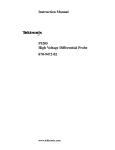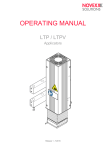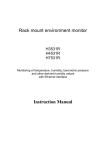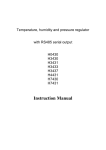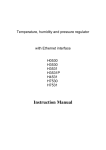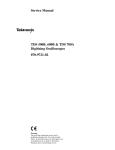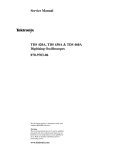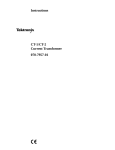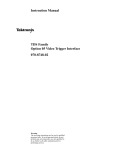Download P5210 High Voltage Differential Probe Service Manual
Transcript
Service Manual P5210 High Voltage Differential Probe 070-9895-03 Warning The servicing instructions are for use by qualified personnel only. To avoid personal injury, do not perform any servicing unless you are qualified to do so. Refer to all safety summaries prior to performing service. www.tektronix.com Copyright © Tektronix, Inc. All rights reserved. Tektronix products are covered by U.S. and foreign patents, issued and pending. Information in this publication supercedes that in all previously published material. Specifications and price change privileges reserved. Tektronix, Inc., P.O. Box 500, Beaverton, OR 97077 TEKTRONIX, TEK, and TEKPROBE are registered trademarks of Tektronix, Inc. WARRANTY Tektronix warrants that the products that it manufactures and sells will be free from defects in materials and workmanship for a period of one (1) year from the date of purchase from an authorized Tektronix distributor. If any such product proves defective during this warranty period, Tektronix, at its option, either will repair the defective product without charge for parts and labor, or will provide a replacement in exchange for the defective product. Batteries are excluded from this warranty. In order to obtain service under this warranty, Customer must notify Tektronix of the defect before the expiration of the warranty period and make suitable arrangements for the performance of service. Customer shall be responsible for packaging and shipping the defective product to the service center designated by Tektronix, shipping charges prepaid, and with a copy of customer proof of purchase. Tektronix shall pay for the return of the product to Customer if the shipment is to a location within the country in which the Tektronix service center is located. Customer shall be responsible for paying all shipping charges, duties, taxes, and any other charges for products returned to any other locations. This warranty shall not apply to any defect, failure or damage caused by improper use or improper or inadequate maintenance and care. Tektronix shall not be obligated to furnish service under this warranty a) to repair damage resulting from attempts by personnel other than Tektronix representatives to install, repair or service the product; b) to repair damage resulting from improper use or connection to incompatible equipment; c) to repair any damage or malfunction caused by the use of non-Tektronix supplies; or d) to service a product that has been modified or integrated with other products when the effect of such modification or integration increases the time or difficulty of servicing the product. THIS WARRANTY IS GIVEN BY TEKTRONIX WITH RESPECT TO THE LISTED PRODUCTS IN LIEU OF ANY OTHER WARRANTIES, EXPRESS OR IMPLIED. TEKTRONIX AND ITS VENDORS DISCLAIM ANY IMPLIED WARRANTIES OF MERCHANTABILITY OR FITNESS FOR A PARTICULAR PURPOSE. TEKTRONIX’ RESPONSIBILITY TO REPAIR OR REPLACE DEFECTIVE PRODUCTS IS THE SOLE AND EXCLUSIVE REMEDY PROVIDED TO THE CUSTOMER FOR BREACH OF THIS WARRANTY. TEKTRONIX AND ITS VENDORS WILL NOT BE LIABLE FOR ANY INDIRECT, SPECIAL, INCIDENTAL, OR CONSEQUENTIAL DAMAGES IRRESPECTIVE OF WHETHER TEKTRONIX OR THE VENDOR HAS ADVANCE NOTICE OF THE POSSIBILITY OF SUCH DAMAGES. Table of Contents General Safety Summary . . . . . . . . . . . . . . . . . . . . . . . . . . . . v Service Safety Summary . . . . . . . . . . . . . . . . . . . . . . . . . . . . . Contacting Tektronix . . . . . . . . . . . . . . . . . . . . . . . . . . . . . . . vii viii Operating Basics . . . . . . . . . . . . . . . . . . . . . . . . . . . . . . . . . . . Operating the Probe Safely . . . . . . . . . . . . . . . . . . . . . . . . . . . . Minimizing Risk of RF Burn (probe leads) . . . . . . . . . . . . . . . . Maximum Input Limits . . . . . . . . . . . . . . . . . . . . . . . . . . . . . . . Operating Characteristics and Probing Techniques . . . . . . . . . Operating Limits . . . . . . . . . . . . . . . . . . . . . . . . . . . . . . . . . . . . Overrange Detection . . . . . . . . . . . . . . . . . . . . . . . . . . . . . . . . . Common-Mode Rejection . . . . . . . . . . . . . . . . . . . . . . . . . . . . . Twisting the Input Leads . . . . . . . . . . . . . . . . . . . . . . . . . . . . . . Extension Leads . . . . . . . . . . . . . . . . . . . . . . . . . . . . . . . . . . . . . Probe Loading . . . . . . . . . . . . . . . . . . . . . . . . . . . . . . . . . . . . . . 1 2 2 2 4 4 4 4 5 5 6 Specifications . . . . . . . . . . . . . . . . . . . . . . . . . . . . . . . . . . . . . . Warranted Characteristics . . . . . . . . . . . . . . . . . . . . . . . . . . . . . Typical Characteristics . . . . . . . . . . . . . . . . . . . . . . . . . . . . . . . Nominal Characteristics . . . . . . . . . . . . . . . . . . . . . . . . . . . . . . 7 7 11 14 Maintenance . . . . . . . . . . . . . . . . . . . . . . . . . . . . . . . . . . . . . . . Cleaning . . . . . . . . . . . . . . . . . . . . . . . . . . . . . . . . . . . . . . . . . . . Replacing TEKPROBE Interface Pins . . . . . . . . . . . . . . . . . . . Removing and Replacing the TEKPROBE Interface Collar . . Removing the Compensation Box Covers . . . . . . . . . . . . . . . . Replacing the Compensation Box Covers . . . . . . . . . . . . . . . . . 15 15 15 16 17 17 Performance Verification . . . . . . . . . . . . . . . . . . . . . . . . . . . . Construction of Modified BNC Adapter . . . . . . . . . . . . . . . . . . Setup . . . . . . . . . . . . . . . . . . . . . . . . . . . . . . . . . . . . . . . . . . . . . Differential Gain Accuracy . . . . . . . . . . . . . . . . . . . . . . . . . . . . Bandwidth . . . . . . . . . . . . . . . . . . . . . . . . . . . . . . . . . . . . . . . . . DC CMRR . . . . . . . . . . . . . . . . . . . . . . . . . . . . . . . . . . . . . . . . . 19 20 21 22 24 25 Replaceable Parts . . . . . . . . . . . . . . . . . . . . . . . . . . . . . . . . . . . Parts Ordering Information . . . . . . . . . . . . . . . . . . . . . . . . . . . . Using the Replaceable Parts List . . . . . . . . . . . . . . . . . . . . . . . . 27 27 27 P5210 High Voltage Differential Probe Service Manual i Table of Contents Abbreviations . . . . . . . . . . . . . . . . . . . . . . . . . . . . . . . . . . . . Mfr. Code to Manufacturer Cross Index . . . . . . . . . . . . . . . ii 28 28 P5210 High Voltage Differential Probe Service Manual Table of Contents List of Figures Figure 1: Safety Limits (voltage between either input and earth ground) . . . . . . . . . . . . . . . . . . . . . . . . . . . . . . . . . Figure 2: Twisting the Input Leads . . . . . . . . . . . . . . . . . . . . . . Figure 3: HF Transient Response with and without extension leads . . . . . . . . . . . . . . . . . . . . . . . . . . . . . . . . . . Figure 4: Safety limits (voltage between either input and earth ground) . . . . . . . . . . . . . . . . . . . . . . . . . . . . . . . . . Figure 5: Typical common-mode rejection ratio (100X attenuation) . . . . . . . . . . . . . . . . . . . . . . . . . . . . . . . . Figure 6: Input impedance vs. frequency . . . . . . . . . . . . . . . . . Figure 7: Replacing TEKPROBE interface pins . . . . . . . . . . . . Figure 8: Replacing the TEKPROBE collar . . . . . . . . . . . . . . . Figure 9: Removing the compensation box covers . . . . . . . . . . Figure 10: Replacing the compensation box cover . . . . . . . . . . Figure 11: BNC-male-to-dual binding post adapter . . . . . . . . . Figure 12: Removing plastic covers from binding posts . . . . . Figure 13: Slide probe leads onto the binding posts . . . . . . . . . Figure 14: P5210 probe and replaceable accessories . . . . . . . . Figure 15: Replaceable parts - compensation box . . . . . . . . . . Figure 16: P5210 probe optional accessories . . . . . . . . . . . . . . P5210 High Voltage Differential Probe Service Manual 3 5 6 9 12 13 16 16 17 18 20 22 23 29 31 32 iii Table of Contents List of Tables Table 1: Warranted electrical characteristics . . . . . . . . . . . . . . Table 2: Certifications and compliances . . . . . . . . . . . . . . . . . Table 3: Typical electrical characteristics . . . . . . . . . . . . . . . . Table 4: Typical mechanical characteristics . . . . . . . . . . . . . . . Table 5: Nominal electrical characteristics . . . . . . . . . . . . . . . Table 6: List of equipment required . . . . . . . . . . . . . . . . . . . . . Table 7: Parts list column descriptions . . . . . . . . . . . . . . . . . . . iv 8 10 11 13 14 19 28 P5210 High Voltage Differential Probe Service Manual General Safety Summary Review the following safety precautions to avoid injury and prevent damage to this product or any products connected to it. To avoid potential hazards, use this product only as specified. Only qualified personnel should perform service procedures. Observe Maximum Working Voltage Do not use the P5210 High Voltage Differential Probe above 1,000 VRMS CAT III (2,200 VRMS CAT II ) from ground on either input or ± 5,600 V (DC + peak AC) between the leads. To Avoid Fire or Personal Injury Avoid RF Burns While Handling Probe. To avoid RF burns, do not handle the probe while the input leads are connected to circuits above the voltage and frequency limits specified in Figure 1 on page 3. Use only probe accessories that are rated for the application. Connect and Disconnect Properly. Connect the probe output to the measurement instrument before connecting the probe to the circuit under test. Disconnect the probe input and the probe ground from the circuit under test before disconnecting the probe from the measurement instrument. Ground the Product. This product is indirectly grounded through the grounding conductor of the mainframe power cord. To avoid electric shock, the grounding conductor must be connected to earth ground. Before making connections to the input or output terminals of the product, ensure that the product is properly grounded. Observe All Terminal Ratings. To avoid fire or shock hazard, observe all ratings and markings on the product. Consult the product manual for further ratings information before making connections to the product. Use Proper AC Adapter. Use only the AC adapter specified for this product. Do Not Operate Without Covers. Do not operate this product with covers or panels removed. Avoid Exposed Circuitry. Do not touch exposed connections and components when power is present. P5210 High Voltage Differential Probe Service Manual v General Safety Summary Do Not Operate With Suspected Failures. If you suspect there is damage to this product, have it inspected by qualified service personnel. Do Not Operate in Wet/Damp Conditions. Do Not Operate in an Explosive Atmosphere. Keep Product Surfaces Clean and Dry. Safety Terms and Symbols Terms in This Manual. These terms may appear in this manual: WARNING. Warning statements identify conditions or practices that could result in injury or loss of life. CAUTION. Caution statements identify conditions or practices that could result in damage to this product or other property. Terms on the Product. These terms may appear on the product: DANGER indicates an injury hazard immediately accessible as you read the marking. WARNING indicates an injury hazard not immediately accessible as you read the marking. CAUTION indicates a hazard to property including the product. Symbols on the Product. These symbols may appear on the product: CAUTION Refer to Manual vi WARNING High Voltage Double Insulated Protective Ground (Earth) Terminal P5210 High Voltage Differential Probe Service Manual Service Safety Summary Only qualified personnel should perform service procedures. Read this Service Safety Summary and the General Safety Summary before performing any service procedures. Do Not Service Alone. Do not perform internal service or adjustments of this product unless another person capable of rendering first aid and resuscitation is present. Use Care When Servicing with Power On. Dangerous voltages or currents may exist in this product. Disconnect power, remove battery (if applicable), and disconnect test leads before removing protective panels, soldering, or replacing components. To avoid electric shock, do not touch exposed connections. P5210 High Voltage Differential Probe Service Manual vii Service Safety Summary Contacting Tektronix Phone 1-800-833-9200* Address Tektronix, Inc. 14200 SW Karl Braun Drive P.O. Box 500 Beaverton, OR 97077 USA Web site www.tektronix.com Sales support 1-800-833-9200, select option 1* Service support 1-800-833-9200, select option 2* Technical support Email: [email protected] 1-800-833-9200, select option 3* 1-503-627-2400 6:00 a.m. - 5:00 p.m. Pacific time * viii This phone number is toll free in North America. After office hours, please leave a voice mail message. Outside North America, contact a Tektronix sales office or distributor; see the Tektronix web site for a list of offices. P5210 High Voltage Differential Probe Service Manual Operating Basics To help you use the P5210 High Voltage Differential Probe safely and effectively, this section provides important information about safety limits, operating characteristics, and probing techniques. WARNING. Due to the inherent hazards associated with taking high-voltage measurements, the product is intended for use by qualified personnel who have had the training to make these types of measurements. Read and follow the precautions specified in this manual. Before you make any oscilloscope measurement, observe all safety precautions described in the user and service manuals for the equipment you are working on. Some general rules about using and servicing electrical equipment are worth repeating here. H Observe the safety instruction symbols for the equipment you are working on. H Consult the instruction or service manuals for the equipment you are working on. H Don’t operate or service an electrical device in an explosive atmosphere. H Avoid personal injury by never touching exposed connections or components in the circuit-under-test when the power is on. P5210 High Voltage Differential Probe Service Manual 1 Operating Basics Operating the Probe Safely Before connecting the inputs of the probe to a circuit, read the safety information in this section, and attach the appropriate accessories to the input connectors of the probe. NOTE. To avoid shock or fire hazard, use only accessories that are rated for the application. Minimizing Risk of RF Burn (Probe Leads) WARNING. To avoid personal injury, do not handle the probe leads when the leads are connected to a source that is above the voltage and frequency limits given in Figure 1 on page 3. The area above these limits poses a risk of radio frequency (RF) burns. If you need to use the probe within the risk area for RF burn, turn power off to the source before connecting or disconnecting the probe leads. Do not handle the input leads while the circuit is active. Maximum Input Limits To prevent damage to the probe, you must observe both the peak and RMS ratings. (The rating for DC voltage is the same as the rating for RMS voltage.) You must also observe the ratings between the differential inputs and between each input and earth ground. CAUTION. To avoid damaging the input circuitry of the P5210, do not apply voltage of more than 2,200 VRMS CAT II between either input and earth ground or more than 4,400 VRMS CAT II between the inputs. In addition, the peak voltage must be less than 5,600 V (DC + peak AC) between the inputs. Above 1.5 MHz, the voltage limit decreases as frequency increases. See Figure 1. The input limit applies to both the 100X and 1,000X settings. 2 P5210 High Voltage Differential Probe Service Manual Operating Basics Category II maximum voltage limit (2,200 V) RF burn risk area (shaded) Voltage derating with frequency 4000 V 1000 V 500 V Voltage (RMS) 100 V 50 V DC or 0 100 k 500 k 1M Frequency (Hz) 5M 10 M 50 M Figure 1: Safety Limits (voltage between either input and earth ground) P5210 High Voltage Differential Probe Service Manual 3 Operating Basics Operating Characteristics and Probing Techniques This section explains the operating characteristics of the P5210 along with techniques you can use to maximize the performance of the probe. Operating Limits The P5210 has two operating ranges that you select with the ATTENUATION button on the front panel: 1,000X and 100X. These ranges set the maximum differential voltage that can be measured. H In the 100X position, the probe can measure differential voltages ≤ 560 V (DC + peak AC). H In the 1,000X position, the probe can measure differential voltages ≤ 5,600 V (DC + peak AC). Always insure that the input voltages never exceed 2,200 VRMS CAT II from either input to ground or 4,400 VRMS CAT II between the inputs. Overrange Detection Differential voltage outside the operating range will overdrive the circuitry of the probe and distort the output signal. When this differential overrange occurs, the probe detects the condition and lights the overrange indicator. With the Audible Overrange ON, the probe will also emit an audible alarm. NOTE. Common-mode voltage greater than 2,200 VRMS CAT II can distort the output signal, but the probe will not indicate an overrange condition. Common-Mode Rejection The common-mode rejection ratio (CMRR) is the specified ability of P5210 to reject signals that are common to both inputs. More precisely, CMRR is the ratio of the differential gain to the commonmode gain. The higher the ratio, the greater the ability of probe to reject common-mode signals. For detailed specifications, see pages 8 and 11 in the Specification section. 4 P5210 High Voltage Differential Probe Service Manual Operating Basics Common mode rejection decreases as the input frequency increases. Figure 5 on page 12 is a plot of typical CMRR of the probe versus input frequency. For example, if you apply a 60 Hz line voltage of 500 VP-P to both input leads of the probe, the probe rejects the signal by 80 dB (typical) and the signal appears as only a 50 mVP-P signal on the oscilloscope screen. Twisting the Input Leads Twisting the input leads as shown in Figure 2 helps to cancel noise that is induced into the input leads and to improve the high-frequency response of the inputs. Figure 2: Twisting the Input Leads Extension Leads The extension leads allow you to reach widely spaced connection points. Connect the extension leads to the input leads using the adapters provided. Be sure to use both extension leads so that the input leads are the same length. P5210 High Voltage Differential Probe Service Manual 5 Operating Basics The extension leads, however, do affect the high-frequency performance of the probe. With longer lead length, differential noise induced into the input leads is greater. Also, because of the added inductance of the leads, voltage measurements at frequencies above approximately 10 MHz may not be as precise. Figure 3 shows the affect on HF transient response. The extension leads do not affect the performance of the probe when bandwidth is set to 5 MHz. Without extension leads 250 mv/div 250 mv/div With extension leads 50 ns/div 50 ns/div Figure 3: HF Transient Response with and without extension leads Probe Loading When you touch your probe tip to a circuit element, you introduce a new resistance, capacitance, and inductance into the circuit. Frequency and impedance of the source determine how much the probe loads the circuit you are measuring. As the frequency of the source starts to increase beyond 1 kHz, the input impedance of the probe begins to decrease. The lower the impedance of the probe relative to that of the source, the more the probe loads the circuit under test. For a graph of frequency versus input impedance, refer to Figure 6 on page 13 of the Specifications section. The probe has virtually no loading effect on sources with relatively low impedance and low frequency. 6 P5210 High Voltage Differential Probe Service Manual Specifications The specifications in Tables 1 through 5 apply to a P5210 probe installed on a Tektronix TDS 460A oscilloscope. When the probe is used with another oscilloscope, the oscilloscope must have: H An input impedance of 1 MΩ H An input capacitance range of between 15 and 20 pF H A bandwidth greater than 200 MHz The probe must have a warm-up period of at least 20 minutes and be in an environment that does not exceed the limits described in Table 1 on page 8. Specifications for the P5210 probe fall into three categories: warranted, typical, and nominal characteristics. WARNING. Special fixtures are required to examine specifications at the maximum frequency and voltage levels and should be conducted only by qualified Service Personnel. See the Service section for more details. Warranted Characteristics Warranted characteristics in Tables 1 and 2 describe guaranteed performance within tolerance limits or certain type-tested requirements. Warranted characteristics that have checks in the Performance Verification procedure appear in boldface type. The Performance Verification procedure begins on page 19. P5210 High Voltage Differential Probe Service Manual 7 Specifications Table 1: Warranted electrical characteristics DC common-mode rejection ratio >3000:1 at 500 VDC, 20-30_ C, <70% RH Bandwidth DC to 50 MHz (-3dB) Gain accuracy ± 3% at 20-30_ C, <70% RH Maximum rated input voltage (Refer to Figure 4 on page 9) probe tip to probe tip 4.4 kVRMS1, Category I & II 1 kVRMS1, Category III 5.6 kV(DC + peak AC)2 probe tip to earth 2.2 kVRMS1, Category I & II3 1 kVRMS1, Category III 5.6 kV(DC + peak AC)2 Temperature4 Operating: 0 to 40_ C Nonoperating: --30 to +70_ C Humidity4 Operating: <85% RH at or below +35_ C Nonoperating: <85% RH at or below +60_ C 1 The rating for DC voltage is the same as the rating for RMS voltage. 2 The input voltage must not exceed this peak rating or the RMS rating. 3 The 2.2 kVRMS CAT II rating applies to high-voltage secondary circuits that have a CAT III primary as described in IEC 664. This rating only applies when using the probe head that is in the 020-2195-00 accessory kit. If you use any other probe head, do not exceed the voltage-to-ground rating of that probe head or this 2.2 kVRMS CAT II rating. 4 Tektronix Design Standard 062-2847-00 8 P5210 High Voltage Differential Probe Service Manual Specifications WARNING. To avoid personal injury, do not handle the probe leads when the leads are connected to a source that is in the voltage and frequency range indicated by the shaded area in Figure 4. This area of operation poses a risk of radio frequency (RF) burns. Category II maximum voltage limit (2,200 V) RF burn risk area (shaded) Voltage derating with frequency 4000 V 1000 V 500 V Voltage (RMS) 100 V 50 V DC or 0 100 k 500 k 1M Frequency (Hz) 5M 10 M 50 M Figure 4: Safety limits (voltage between either input and earth ground) P5210 High Voltage Differential Probe Service Manual 9 Specifications Table 2: Certifications and compliances EC Declaration of Conformity -- Low Voltage Compliance was demonstrated to the following specification as listed in the Official Journal of the European Communities: Low Voltage Directive 73/23/EEC, as amended by 93/68/EEC: EN 61010-1/A2:1995 Safety requirements for electrical equipment for measurement, control, and laboratory use EN 61010-2-031:1994 Particular requirements for hand-held probe assemblies for electrical measurement and test equipment Approvals UL3111-1 -- Standard for electrical measuring and test equipment IEC 61010-2-031 -- Particular requirements for hand-held probe assemblies for electrical measurement and test CAN/CSA-C22.2 No. 1010.1-92 and CAN/CSA-C22.2 No. 1010.2.031-94 -- Safety requirements for electrical equipment for measurement, control, and laboratory use Installation Category Descriptions Pollution Degree 2 10 Terminals on this product may have different installation category designations. The installation categories are: CAT III Distribution-level mains (usually permanently connected). Equipment at this level is typically in a fixed industrial location CAT II Local-level mains (wall sockets). Equipment at this level includes appliances, portable tools, and similar products. Equipment is usually cord-connected CAT I Secondary (signal level) or battery operated circuits of electronic equipment Do not operate in environments where conductive pollutants may be present. P5210 High Voltage Differential Probe Service Manual Specifications Typical Characteristics Typical characteristics in Tables 3 and 4 describe typical but not guaranteed performance. Table 3: Typical electrical characteristics Rise time 7 ns Bandwidth limit 5 MHz AC common-mode rejection ratio (20-30_C, <70% RH) See Figure 5 60 Hz: > 10,000:1 100 kHz: > 300:1 1 MHz: > 300:1 AC noise (referenced to input) 100X: < 150 mVRMS 1,000X: < 800 mVRMS Input impedance 16 MΩ, 3.5 pF between inputs 8 MΩ, 7 pF between each input and ground See Figure 6 on page 13 Propagation delay 20 nS Overdrive recovery < 50 ns to 10% of final value after 10X overdrive (100X range only) DC offset adjust (referenced to input) 100X: ± 1.0 V 1,000X: ± 10 V P5210 High Voltage Differential Probe Service Manual 11 Specifications 40 dB 50 dB 60 dB 70 dB 80 dB 90 dB 1 Hz 10 Hz 100 Hz 1 kHz 10 kHz 100 kHz 1 MHz Frequency Figure 5: Typical common-mode rejection ratio (100X attenuation) 12 P5210 High Voltage Differential Probe Service Manual Specifications Table 4: Typical mechanical characteristics Dimensions, case 185 mm × 66 mm × 32 mm (7.2 in × 2.6 in × 1.3 in) Dimensions, input leads 45.7 cm (18 in) Dimensions, output cable 1.8 m (6 ft) Unit weight (probe only) 315 g (11 oz) Shipping weight (with accessories) 1.42 kg (3 lb, 2 oz) 10 M Impedance (ohms) 1M 100 k 10 k 1k 100 1 10 100 1k 10 k 100 k 1M 10 M 50 M Frequency (Hz) Figure 6: Input impedance vs. frequency P5210 High Voltage Differential Probe Service Manual 13 Specifications Nominal Characteristics Nominal characteristics in Table 5 describe guaranteed traits, but the traits do not have tolerance limits. Table 5: Nominal electrical characteristics Input type Balanced differential Output type Single-ended. Source impedance of 50 Ω drives 1 MΩ oscilloscope input. Load impedance must be greater than 50 kΩ for stated accuracy Gain Switchable: 1/100 (100X) and 1/1,000 (1000X) Overrange beeper Overrange sounds whenever ON, and over range LED is lit. 14 P5210 High Voltage Differential Probe Service Manual Maintenance Refer to this section for information about maintaining and servicing the P5210 High Voltage Differential Probe. For a list of replaceable parts, refer to the Replaceable Parts section on page 27. The replaceable parts of the TEKPROBE interface include the interface pins, the probe collar, and the compensation box covers. Cleaning Remove dirt with a soft cloth dampened in a mild detergent and water solution, or isopropyl alcohol. CAUTION. To avoid damaging the probe, use only a mild detergent and water solution or isopropyl alcohol and water; do not use any other solvents or abrasive cleaners. Do not immerse the probe. Replacing TEKPROBE Interface Pins 1. Remove the interface pin with pliers (see Figure 7 on page 16). 2. Insert a new pin and press it into the socket against a hard surface. P5210 High Voltage Differential Probe Service Manual 15 Maintenance Figure 7: Replacing TEKPROBE interface pins Removing and Replacing the TEKPROBE Interface Collar 1. Firmly pull the collar off by hand. 2. Align the smaller group of pins with the smaller of the two holes in the interface collar and align the tabs with the slots. 3. Gently press the two pieces together (see Figure 8 below). Tab Slot Figure 8: Replacing the TEKPROBE collar 16 P5210 High Voltage Differential Probe Service Manual Maintenance Removing the Compensation Box Covers 1. Press the optional release tool pins into the cover catches. 2. Gently separate the each side of the compensation box. Refer to Figure 9 below. 003-1383-00 Cover catches Figure 9: Removing the compensation box covers Replacing the Compensation Box Covers 1. Carefully align the tab and cover catches. Refer to Figure 10 on page 18. 2. Firmly press the pieces together until the cover catches snap into place. P5210 High Voltage Differential Probe Service Manual 17 Maintenance Tab Cover Catches Figure 10: Replacing the compensation box cover 18 P5210 High Voltage Differential Probe Service Manual Performance Verification The following procedure verifies the warranted electrical characteristics of the P5210 High Voltage Differential Probe. Table 6 itemizes the equipment required, provides an example or part number of the equipment, and explains the purpose of the equipment. Table 6: List of equipment required Description Minimum requirements Example or part number Purpose Digitizing oscilloscope Bandwidth: ≥ 400 MHz TDS460A TekProbe interface or TDS784A offset accuracy: ≤ 0.7% Display probe output Standard amplitude generator Amplitude accuracy: ≤ 0.25% Fluke/Wavetek 9100 with oscilloscope option 250 Check probe attenuation, bandwidth, common-mode rejection ratio Leveled sine wave Rise time (standard generator amplitude): ≤ 3 ns DC voltage source Plunger clamps (2 required) Use clamps included in accessory kit Accessory kit 020-2106-00 Connection to binding post BNC adapter BNC female to dual banana 103-0090-00 Interconnection between probe and generator Coaxial cables (2 required) 36 in (0.9144 m), precision 50 Ω 012-0482-00 Interconnection between probe and generator Terminator 50 Ω precision feed through 011-0049-01 Termination between probe and generator during bandwidth measurements Modified BNC adapter BNC--male--to--dual binding post 103-0035-00 Interconnection be tween probe and Generator. (See Figure 11 on page 20) P5210 High Voltage Differential Probe Service Manual 19 Performance Verification Construction of Modified BNC Adapter Construct the modified BNC Adapter from a BNC-male-to-dual binding post adapter, Tektronix part number 103 -0035-00 (see Figure 11). Black and red plastic post covers Figure 11: BNC-male-to-dual binding post adapter To expose the posts that you will connect the P5210 High Voltage Differential probe leads to, remove the black and red plastic post covers of the BNC-male -to-dual adapter. Use a pair of pliers and a vise to remove the plastic covers, as shown in Figure 12 on page 22. 20 P5210 High Voltage Differential Probe Service Manual Performance Verification Setup WARNING. These procedures require the application of high voltage to the inputs of the P5210 probe. Because this adapter has exposed metal surfaces, only qualified personnel should perform any testing with voltage levels exceeding 30 V rms. All pertinent safety rules and guidelines for elevated voltage measurements should be followed and adhered to. Connect the output of the probe to the channel 3 of the test oscilloscope. Let the probe warm up for 20 minutes. NOTE. These procedures assume that you are using an oscilloscope that automatically displays the correct volts/division scale factor for the attenuation setting of the probe. If not, you must take the attenuation setting of the probe into account when setting the volts/division on the oscilloscope. P5210 High Voltage Differential Probe Service Manual 21 Performance Verification Pliers Plastic cover removed Modified BNC adapter Vise Figure 12: Removing plastic covers from binding posts Differential Gain Accuracy 1. Set the volts/division on channel 2 of the oscilloscope to 2 V. H Trigger on channel 2. H Select 1 MΩ impedance (if option exists on oscilloscope). H Connect coaxial cable between TRIG OUT of the generator (rear of Wavetek 9100) and channel 2 of the oscilloscope. 2. Set the volts/division on channel 1 of the oscilloscope to 20 mV. 3. Set the seconds/div to 200 s and the acquisition mode to average 32. 4. Connect the coaxial cable from SIG OUT of the generator (rear of Wavetek 9100) to channel 1 of the oscilloscope. 5. Set the generator to 0.1 V and 1 kHz (AUX, square wave, 1 MΩ load). Enable the output. 22 P5210 High Voltage Differential Probe Service Manual Performance Verification 6. Select the amplitude measurement on the oscilloscope and record the DC amplitude (∼ 100 mV) of the square wave. This measurement is only the oscilloscope. 7. Disable the generator output. Disconnect the coaxial cable from channel 1 of the oscilloscope and SIG OUT of the generator. 8. Connect the output of the probe to channel 1 of the oscilloscope. 9. Attach the Modified BNC adapter to the SIG OUT of the generator. 10. Attach the differential probe input leads (without attachment accessories) by sliding the banana plug of the leads onto the binding posts of the Modified BNC adapter, as shown in Figure 13 on page 23. Modified BNC adapter (+) Post (-) Post Banana plug of an input probe lead Figure 13: Slide probe leads onto the binding posts WARNING. To reduce the risk of electric shock, ensure the generator output is disabled before setting the voltage above 30Vrms. 11. Set the probe to 1000X (out). Set the generator for a 100 V and 1 kHz standard amplitude output (AUX, square wave, 1 MΩ load). P5210 High Voltage Differential Probe Service Manual 23 Performance Verification WARNING. Generator produces hazardous voltages. To avoid risk of shock, do not touch exposed metal parts after the generator output is enabled. 12. Enable the output of the generator. 13. Adjust the zero offset on the compensation box of the probe for zero offset. 14. Record the DC amplitude of the square wave (∼100 V) and divide 1/1000th of this into just the amplitude of the oscilloscope (refer to step 6). Verify that only the probe gain accuracy is ᐔ3%. 15. Set the calibration generator for 10 V output. Set the attenuation button on the probe to 100X (in). 16. Record the DC amplitude of the square wave (∼10V) and divide 1/100th of this into only the amplitude of the oscilloscope (refer to step 6). Verify that only the probe gain accuracy is ᐔ3%. 17. Disable the generator output and leave the setup connected for the next procedure. Bandwidth 1. Connect the Modified BNC adapter through a 50 Ω terminator to the leveled sine wave output of the generator (AUX, Sine, 50 Ω load). WARNING. To reduce the risk of electric shock, ensure the generator output is disabled before modifying/disconnecting test setup or connections since exposed metal may at a hazardous potential. It is recommended that the generator output amplitude be reduced to minimum prior to disabling the output. 2. Attach the differential probe input leads without attachment accessories by sliding the banana plug of the leads onto the binding posts metal sleeves on the Modified BNC adapter. 24 P5210 High Voltage Differential Probe Service Manual Performance Verification 3. Set the bandwidth on the probe to FULL and the attenuation button to 100X. 4. Set the Volts/Division on channel 1 of the oscilloscope to 500 mV, and seconds/div to 10 s. Set the trace to the center of the oscilloscope. 5. Reduce the amplitude on the generator to minimum then enable the output. 6. Set the sine wave generator to 50 kHz, and adjust the amplitude to 3.00 V as measured on the oscilloscope. 7. Set the generator to 50 MHz, and set the oscilloscope to 5 ns/division. Check for ≥ 2.1 V amplitude. 8. Disable the generator output and disconnect the probe input. DC CMRR 1. Set the attenuation of the probe to 100X. 2. Set the oscilloscope input coupling to DC, the vertical to 100 mV/div, and the seconds/div to 200 s. Center the trace on the display. Set the acquisition mode to average 32. 3. Attach the BNC-female-to-dual-banana adapter to the DC output of the generator (front of Wavetek 9100). Attach the modified BNC adapter to the BNC-female-to-dual-banana adapter. 4. Attach the plunger clamps on the differential probe input leads. 5. Twist the input leads together as shown in Figure 2 on page 5, and connect both probe inputs to the positive terminal of the modified BNC adapter. 6. Adjust the offset on the probe output to zero. WARNING. Generator produces hazardous voltages. To avoid risk of shock, do not touch exposed metal parts after the generator output is enabled. P5210 High Voltage Differential Probe Service Manual 25 Performance Verification 7. Set the output of the generator to 500 VDC. 8. Enable the output. 9. Check that the trace on the oscilloscope shifts less than 1.67 divisions (167 mV) from center. 10. Disable the generator output. WARNING. To reduce the risk of electric shock, ensure the generator output is disabled before modifying/disconnecting test setup or connections since exposed metal may at a hazardous potential. It is recommended that the generator output amplitude be reduced to minimum prior to disabling the output. 11. Disconnect all test equipment. This completes the performance verification procedure. 26 P5210 High Voltage Differential Probe Service Manual Replaceable Parts This section contains a list of the replaceable modules for the P5210 probe. Use this list to identify and order replacement parts. Parts Ordering Information Replacement parts are available through your local Tektronix field office or representative. Changes to Tektronix instruments are sometimes made to accommodate improved components as they become available and to give you the benefit of the latest circuit improvements. Therefore, when ordering parts, it is important to include the following information in your order: H Part number H Instrument type or model number H Instrument serial number H Instrument modification number, if applicable If you order a part that has been replaced with a different or improved part, your local Tektronix field office or representative will contact you concerning any change in part number. You may exchange your module for a remanufactured module. These modules cost significantly less than new modules and meet the same factory specifications. For more information about the module exchange program, For more information about the module exchange program, refer to Contacting Tektronix, on page viii. Using the Replaceable Parts List This section contains a list of the mechanical and/or electrical components that are replaceable for the P5210 probe. Use this list to identify and order replacement parts. Table 7 describes each column in the parts list. P5210 High Voltage Differential Probe Service Manual 27 Replaceable Parts Table 7: Parts list column descriptions Column Column name Description 1 Figure & index number Items in this section are referenced by figure and index numbers to the exploded view illustrations that follow. 2 Tektronix part number Use this part number when ordering replacement parts from Tektronix. 3 and 4 Serial number Column three indicates the serial number at which the part was first effective. Column four indicates the serial number at which the part was discontinued. No entries indicates the part is good for all serial numbers. 5 Qty This indicates the quantity of parts used. 6 Name & description An item name is separated from the description by a colon (:). Because of space limitations, an item name may sometimes appear as incomplete. Use the U.S. Federal Catalog handbook H6-1 for further item name identification. 7 Mfr. code This indicates the code of the actual manufacturer of the part. 8 Mfr. part number This indicates the actual manufacturer or vendor part number. Abbreviations Abbreviations conform to American National Standard ANSI Y1.1-- 1972. Mfr. Code to Manufacturer Cross Index The table titled Manufacturers Cross Index shows codes, names, and addresses of manufacturers or vendors of components listed in the parts list. 28 P5210 High Voltage Differential Probe Service Manual Replaceable Parts 1 2 3 4 5 Figure 14: P5210 probe and replaceable accessories P5210 High Voltage Differential Probe Service Manual 29 30 Qty 1 1 1 020-- 2195-- 00 016-- 1461-- 00 070-- 9841-- XX 070-- 9895-- XX -4 -5 1 016-- 0633-- 00 -3 1 1 003-- 1433-- 00 Serial no. discont’d -2 Serial no. effective 1 Tektronix part number 14-- 1 Fig. & index number P5210 probe and replaceable accessories MANUAL,TECH:SERVICE,P5210,DP MANUAL,TECH:INSTRUCTION, 4 LANGUAGES,P5210,DP STRAP:SOFT CASE FOR P5205, P5200, SECURES PROBE TO INSTRUMENT UNDER TEST, SECURES ALL ACCESSORIES KIT:ACCESSORIES FOR P5210 MARKER SET,CA:2 EA VARIOUS COLORS SCREWDRIVER:ADJUSTMENT TOOL,METAL TIP PLASTIC,BLACK PROBE, DIF ACT:TEK PROBE, P5210 Name & description TK2548 TK2548 TK6076 80009 80009 TK2565 80009 Mfr. code 070-- 9895-- XX 070-- 9841-- XX 016-- 1461-- 00 020-- 2195-- 00 016-- 0633-- 00 003-- 1433-- 00 Mfr. part number Replaceable Parts P5210 High Voltage Differential Probe Service Manual 2 4 5 Tektronix part number 205-- 0191-- 00 131-- 3627-- 01 206-- 0429-- 08 334-- 9265-- 00 206-- 0430-- 00 Fig. & index number 15-- 1 -2 -3 -4 -5 Serial no. effective Serial no. discont’d Replaceable parts - compensation box P5210 High Voltage Differential Probe Service Manual 1 1 1 1 1 Qty COMP BOX:COVER,BOTTOM HALF MARKER,IDENT:COMP BOX ID LABEL,GE LEXAN,P5210 COMP BOX HALF:P5205,COMP BOX HALF CONTACT,ELEC:GOLD PLATED TIP 206-- 0430-- 00 334-- 9265-- 00 80009 80009 206-- 0429-- 08 P-- 6158-- 1 205-- 0191-- 00 Mfr. part number TK2565 18359 80009 Mfr. code NOTE: Parts illustrated with dashed lines are not replaceable SHELL,ELEC CONN:BNC,ABS,DOVE GRAY Name & description Figure 15: Replaceable parts - compensation box 1 3 Replaceable Parts 31 32 1 1 013-- 0290-- 01 1103 1 -2 Qty 003-- 1383-- 00 Serial no. discont’d 16-- 1 Serial no. effective Tektronix part number Fig. & index number Optional accessories 2 TEKPROBE IF PS:W/OFFSET 2 CONN HOOKTIP,SET:BLACK,LARGE AND SMALL RLSE TOOL,COVER:COMP BOX,POLYCARBONATE Name & description Figure 16: P5210 probe optional accessories 1 80009 TK2469 TK2565 Mfr. code 1103 012-- 0290-- 01 003-- 1383-- 00 Mfr. part number Replaceable Parts P5210 High Voltage Differential Probe Service Manual Manufacturer PYLON CO. INC. TEKTRONIX INC UNITREK CORPORATION XEROX CORPORATION VISION PLASTICS INC FOARM INC Mfr. code 18359 80009 TK2469 TK2548 TK2565 TK6076 Manufacturers cross index 501 E GUTIERREZ ST 26000 SW PARKWAY CENTER DRIVE 14181 SW MILLIKAN WAY 3000 LEWIS & CLARK HWY SUITE 2 14150 SW KARL BRAUN DR PO BOX 500 51 NEWCOMB ST Address SANTA BARBARA, CA 93103 WILSONVILLE, OR 97070 BEAVERTON, OR 97005 VANCOUVER, WA 98661 BEAVERTON, OR 97077-- 0001 ATTLEBORO, MA 02703-- 1403 City, state, zip code Replaceable Parts P5210 High Voltage Differential Probe Service Manual 33 Replaceable Parts 34 P5210 High Voltage Differential Probe Service Manual














































